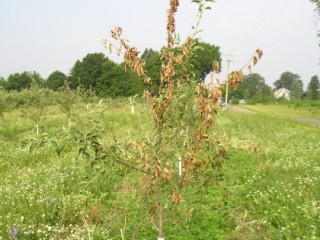
Fireblight is usually associated with pears but it can cause significant losses on certain susceptible apple varieties notably Gala and Egremont Russet, and on late flowering cider apple varieties Vilberie and Brown Snout. Young apple trees are particularly susceptible.
The first obvious symptoms are dead blossomsor dark brown leaves hanging from a truss or branch.
- These result from spring or summer infection of blossom.
- The bark of diseased areas or branches (cankers) is dark-green or dark brown, often water soaked and with an indistinct margin between healthy and infected tissue.
- Shoot infection on apple is characteristic.
- Initially the tips wilt and droop without browning and at this stage golden droplets of bacterial ooze are often seen on the affected stem.
- Later, leaves and stem become brown.
- Symptoms also appear on fruit as brown irregular blotches, resembling bruises or sun scorch.
- During warm humid weather, a glistening whitish/cream bacterial slime may ooze from affected shoots, branches and fruits.
- In dry weather, ooze becomes desiccated and appears as a silvery film on affected surfaces.
The lifecycle and epidemiology involves the bacterium overwintering in orchard trees and in hedgerow hawthorn and susceptible ornamentals in adjacent gardens in bark tissue along the edges of cankers formed from previous year’s infections. In spring these bacteria multiply and produce ooze.
In wet weather ooze spread by wind blown rain and insects infects flowers in spring or shoot tips. E. amylovora can also invade via wounds (especially young shoots damaged by hail or wind) and natural openings such as nectathodes, hydathodes, lenticels, leaf scars. The bacteria then invade the tissues giving rise to typical symptoms.
Fireblight risk is greatest when temperatures exceed 18oC and there is rain. Disease development occurs between 5-30oC with an optimum temperature of 27oC.
